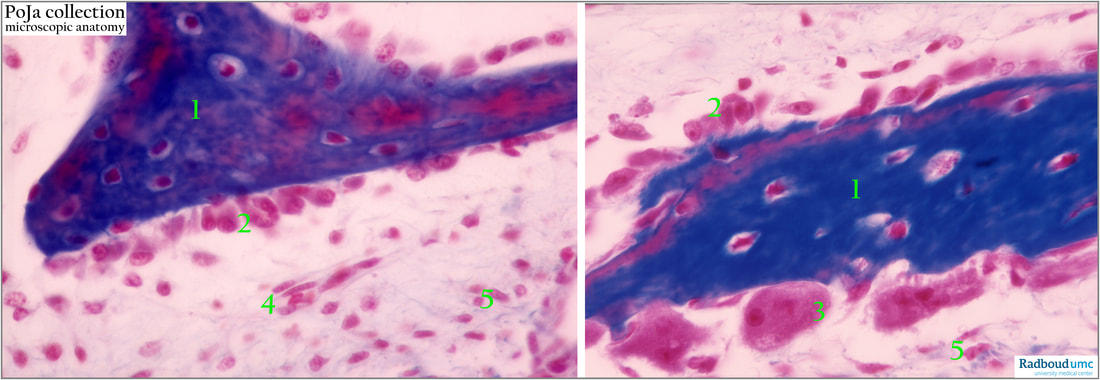16.1.3 POJA-L7052+7053 Development of flat bones 3
16.1.3 POJA-L7052+7053 Development of flat bones 3
Title: Development of flat bones 3
Description:
(A and B): Human foetus, Azan stain. Intramembranous formation of facial bone (desmal ossification).
(1): Osteoid with osteocytes, partly mineralised (reddish coloration).
(2): Osteoblast, with a single nucleus. (3): Osteoclast, usually multinucleated.
(4): Capillary.
(5): Mesenchymal cells.
Background:
Mesenchymal stem cells-derived osteoprogenitor cells (osteoblast precursor cells) differentiate under the influence of the runt-related transcription factor 2 (RUNX2) and become osteoblasts. The osteoblasts are secretory cells that produce the ECM by secreting type I collagen and bone matrix proteins (BMP’s). A hyaline ground substance is deposited as osteoid. This so-called osteoid is defined as collagenous fibres (mostly type I collagen that comprises 90% of the osteoid) masked by a hyaline ground substance (mostly made up of chrondroitin sulphate and osteocalcin), just before calcification (mineralisation) starts. When the polynuclear cells (with many lysosomes) degrade osteoid material they create small bays termed Howship’s lacunae or resorption bays. In contrast to older theories nowadays it is clear that osteoclasts are not related to osteoblasts or osteocytes. Differentiation of mononuclear haematopoietic cells from the lineage of granulocyte/macrophage progenitor cells results in osteoclast precursors.
See also:
Keywords/Mesh: locomotor system, bone, foetus, desmal ossification, flat bone, mesenchyme, osteoblast, osteoid, osteoclast, histology, POJA collection
Title: Development of flat bones 3
Description:
(A and B): Human foetus, Azan stain. Intramembranous formation of facial bone (desmal ossification).
(1): Osteoid with osteocytes, partly mineralised (reddish coloration).
(2): Osteoblast, with a single nucleus. (3): Osteoclast, usually multinucleated.
(4): Capillary.
(5): Mesenchymal cells.
Background:
Mesenchymal stem cells-derived osteoprogenitor cells (osteoblast precursor cells) differentiate under the influence of the runt-related transcription factor 2 (RUNX2) and become osteoblasts. The osteoblasts are secretory cells that produce the ECM by secreting type I collagen and bone matrix proteins (BMP’s). A hyaline ground substance is deposited as osteoid. This so-called osteoid is defined as collagenous fibres (mostly type I collagen that comprises 90% of the osteoid) masked by a hyaline ground substance (mostly made up of chrondroitin sulphate and osteocalcin), just before calcification (mineralisation) starts. When the polynuclear cells (with many lysosomes) degrade osteoid material they create small bays termed Howship’s lacunae or resorption bays. In contrast to older theories nowadays it is clear that osteoclasts are not related to osteoblasts or osteocytes. Differentiation of mononuclear haematopoietic cells from the lineage of granulocyte/macrophage progenitor cells results in osteoclast precursors.
See also:
- 16.1.3 POJA-L7062+7066 Osteoblasts 1
- 16.1.3 POJA-L7063+7064+7065 Osteoblasts 2
- 16.1.3 POJA-L7067+7068+7072 From osteoblast to osteocyte 1
- 16.1.3 POJA-L7126+7120+7122 From osteoblast to osteocyte 2
- 16.1.3 POJA-L7048 Development of flat bones 1
- 16.1.3. POJA-L7049+7050+7054 Development of flat bones 2
Keywords/Mesh: locomotor system, bone, foetus, desmal ossification, flat bone, mesenchyme, osteoblast, osteoid, osteoclast, histology, POJA collection

